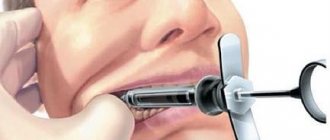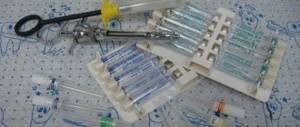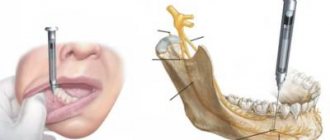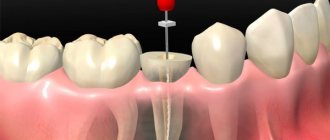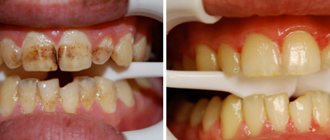The technology of intraligamentous or intraligamentary anesthesia was discovered in France at the beginning of the last century, however, today it remains one of the relevant methods of anesthesia. Anesthesia of tissues and elements of the dentition is achieved through injections of an anesthetic solution injected into the periodontal crevices. The increased pressure that occurs when the composition is supplied ensures that the main volume enters the alveolar region, and, as a consequence, into the periapical structure.
The method under consideration is characterized by a number of distinctive features, including:
- Rapid onset of analgesic effect - usually no more than a minute passes from the moment of injection;
- Maintaining the achieved state for half an hour, which is quite enough for most dental operations;
- Minimum requirements for the implementation of the protocol and the absence of painful sensations from the injection;
- No tissue numbing effect after completion of the procedure.
These properties ensure a positive response to treatment in both adults and young patients. The technology, as a rule, is recommended for the treatment of children, since it is not associated with negative side effects, and simplifies the treatment of pathologies of the jaw region.
Areas of application and contraindications
Clinical situations in which intraperiodontal anesthesia is recommended include:
- Removal of pulp and extraction of dental elements;
- Therapy aimed at treating caries in superficial and medium forms of development;
- Planning the installation of artificial crowns;
- Preparation of tooth enamel in the preparation of supporting units for dentures;
- Treatment of inflammatory processes localized in the tissues of the oral cavity.
In addition, the technique is recommended for the treatment of pregnant and young patients, which is due to the absence of pain and side effects.
Among the contraindications that limit the possibility of anesthesia in accordance with the protocol under consideration, it is worth highlighting:
- The presence of purulent formations in the periodontal structure;
- Formation of gumboil, cysts and periodontal pockets;
- The need for treatment or other procedures with the fangs.
The last limitation is due to the lower probability of a successful outcome of anesthesia, resulting in the achievement of an analgesic effect only in four cases out of ten. Such low rates are associated with the peculiarities of the anatomical structure of this category of teeth, which have an elongated root part.
Anesthesia in modern dentistry has long become a comfortable and completely painless procedure. After all, the doctor has everything to ensure that the patient does not feel anything except a little pressure during the appointment.
Anesthesia is divided into several types and stages. Types of local anesthesia
- Appliqué
- Infiltration
- Conductor
- Intrapulpar
- Intraligamentary
- Osteocentral
Application anesthesia
For initial targeted anesthesia, application anesthesia is used: the area around the tooth is smeared with gel on a sterile cotton swab, which gives the effect of slight numbness in the gum area in just 30 seconds, thanks to which the injection site becomes completely insensitive.
For all types of anesthesia, a carpule syringe and a carpule with an anesthetic, which has a small, hair-thin needle, are used. The anesthetic itself is administered very slowly, and sometimes even in portions, thereby not giving the patient any sensitivity other than a feeling of fullness.
Infiltration anesthesia
This anesthesia is most often performed for the treatment of teeth in the upper jaw, in the treatment of caries, tooth extraction, root canal treatment of a tooth, tooth root resection, frenuloplasty, gumplasty, implantation, sinus lift. Less often, on the lower jaw, only when necessary - during professional oral hygiene, periodontal cleaning and minor treatment of the front teeth. This type of anesthesia occurs very quickly, literally 3-5 minutes, and its effect lasts no more than 1.5 hours.
Conduction anesthesia
This anesthesia is performed only on the lower jaw, during the treatment of caries, pulpitis, and tooth extraction. It is not inserted into the area of intended treatment, but closer to the nerve responsible for this area of the jaw. With such anesthesia, half of the jaw, half of the tongue, half of the lower lip and the cheek on the side of which anesthesia was administered go numb. This type of anesthesia has a great advantage over infiltration anesthesia - during its onset, several teeth can be treated or removed at once. Such anesthesia does not occur immediately, but after 10-15 minutes, but its effect lasts up to 4 hours. During any anesthesia, the patient’s face does not change in any way, there are no asymmetric changes, these are just sensations. To make the anesthesia go away a little faster, after treatment it is recommended to drink warm tea or any other warm drink. Eating after general anesthesia is not recommended due to the high probability of injury to the cheek or lip, since they are practically insensitive.
Intrapulpal anesthesia
This type of anesthesia is performed when there is a lack of conduction or infiltration during the treatment of tooth canals. A very thin needle of 0.3 mm with a shortened bevel is used. It can be adapted (bent) to fit any cavity. In this case, anesthesia is administered directly into the pulp, where the nerve of the tooth is located.
Intraligamentary (intraligamentous) anesthesia
Intraligamentary anesthesia is administered into the periodontal ligament around the tooth. It is also added for infiltration and conduction anesthesia, if they are not enough. The duration of this anesthesia is 30-40 minutes. The anesthetic is administered very little and slowly. Typically, such anesthesia alone is not enough to treat or remove a tooth.
Osteocentral anesthesia
This anesthesia is administered directly into the bone using a special electronic device. You can numb up to 6 teeth completely painlessly with 1 injection. A huge advantage of this anesthesia is that you can forget about the fear of biting your lip - there will be no anemia. The tip of the device is controlled like a pen, which makes the procedure even more comfortable for the patient.
Modern anesthetics for local anesthesia in dentistry
Modern anesthetics are made on the basis of Articaine. It is superior to the outdated novocaine and lidocaine. Contained in anesthetics: Ubistezin, Ultracaine, Septonest. Many anesthetics also contain adrenaline and epinephrine; they help the anesthesia last longer by constricting blood vessels in the injection area.
Ultracain DS forte is most often used for conduction anesthesia.
Ultracaine DS is used for infiltration anesthesia, as well as for children, pregnant and lactating women and people with high blood pressure.
Ubestezin and Ubestezin-forte are used for conduction and infiltration anesthesia. Contains articaine and epinephrine.
Septanest - this anesthetic contains, in addition to articaine and epinephrine, adrenaline, therefore it is contraindicated in children, patients with tachycardia and anemia. But due to vasoconstriction in patients without contraindications, anesthesia with this anesthetic occurs much faster and its effect is longer.
Skandanest - this anesthetic is made on the basis of mepivacaine. It is used for conduction and infiltration anesthesia, in the treatment of caries, tooth extraction, etc. Has a fast and strong effect for up to four hours.
{jlcommentspro}
Types of anesthetics and injectors
For intraligamentous anesthesia, special carpule syringes are used. A wide range of models are available in dentistry, but they all meet standard criteria, which include:
- Maintaining high blood pressure during injection;
- The presence in the structure of a special liquid drainage system;
- Equipped with a rotary or angled attachment that changes the inclination of the needle.
In addition, a prerequisite is the use of materials that are resistant to sterilization procedures, ease and ease of use.
Among the popular models of carpule syringes are:
- STERINJECT and PERI-PRESS are cross-shaped products that include a latch for simultaneous fixation with four fingers. Application of muscle force allows 0.2 ml of anesthetic to be injected with each lever press;
- CITOJECT – models similar in shape to a standard fountain pen. The presence of a piston element and a comb ensures the introduction of 0.3 ml of the composition during injection;
- PAROJECT – hollow small-sized cylindrical syringes, made of metal, and delivering up to 0.6 ml of solution per press.
In addition, other models are also popular among dentists, including the Russian development IS-01-1-Mid, which is distinguished by its rotating head design.
Anesthetics used for pain relief belong to the category of capsule formulations with local action. A standard ampoule contains 1.8 ml of a solution containing an amide anesthetic and a vasoconstrictor.
Local anesthesia in dentistry: types and preparations
In dentistry, both therapeutic and surgical, different types and techniques of anesthesia are used, for example, conduction, infiltration, intracanal, intraosseous, intraligamentary (intraligamentous), tuberal and others. Their differences lie in the place of application and in some features of their effects. As a rule, modern dental clinics in Moscow use carpule anesthesia. This means that the anesthetic is supplied in disposable carpules - a kind of cartridges with an anesthetic solution that are inserted into syringes with screw-on disposable needles. Due to this, the carpules remain sterile, since the dentist does not have to open them, thereby eliminating contact of the medicine with air.
Advantages of the technique
Among the positive aspects that characterize intraligamentary anesthesia are:
- Convenient protocol implementation that does not require special skills;
- Effective action of the composition, guaranteeing the required result in 99% of cases;
- Safety and painlessness of the procedure for patients;
- Promptly achieving the desired effect.
The technology provides correct pain relief, allowing for almost any type of dental intervention.
General anesthesia in dentistry
In some cases, the patient may require dental treatment under general anesthesia. As a rule, it is used when serious and long-term treatment is necessary, for example, the removal of several teeth at a time or complex operations on the jaw. An indication for the use of general anesthesia in dentistry may also be serious dental phobia or a disease in which a person cannot adequately communicate with the doctor, or he may have unexpected reactions to the doctor’s actions, as, for example, with epilepsy.
As an alternative to general anesthesia to correct mood and relieve fear of dental treatment, there is sedation in dentistry. It does not “turn off” consciousness, but puts you into half-asleep and calms you down, helps you relax, and perceive what is happening in a positive way. However, sedation is not anesthesia, so it is used in combination with local anesthesia.
When is anesthesia used in pediatric dentistry?
Most adults have a fear of dental treatment left over from childhood, so today one of the tasks of a pediatric dentist is to prevent the occurrence of dental phobia or get rid of fears that have already formed in the child. General anesthesia is often the only way to solve dental problems in children under three years of age, as well as in children with developmental disabilities, in particular with autism, Down syndrome, cerebral palsy or epilepsy.
It is not always necessary to carry out dental treatment in children under anesthesia. A small patient who comes to a kind and open doctor will be able to perform most of the manipulations while conscious. The main condition is that these manipulations must be painless. According to some studies, today the most painful procedure for a child is the anesthetic injection itself. That is why in pediatric dentistry, before an injection, topical anesthesia is used, the preparations for which have a pleasant taste, which contributes to a good mood in children and their cooperation with the doctor.
In addition, today in dentistry it is no longer uncommon to have a device for computer anesthesia, which allows painless administration of medicine and clearly measuring its correct dosage.
General overview
Intraligamentary anesthesia is a variant of local anesthesia, the principle of which is to introduce a composition that has a point effect in the periodontal space.
The specificity of this method is the higher pressure during the drug delivery process than with standard anesthesia.
If the pressure force is within normal limits, then a small percentage of the composition will be localized in the periodontal slit-like cavity, and the main liquid will reach the intraosseous layers of the alveolar. From there it will begin to spread to the periapical zone, giving the analgesic an intraosseous effect.
The main objective of the procedure is to relieve pain in soft fragments of the oral cavity and hard dental tissues during surgical procedures.
The composition begins to act within a minute after administration of the drug, and the lasting effect lasts for half an hour. This period of time is quite enough to carry out not only standard surgical procedures, but also operations of medium and high levels of complexity.
The most justified use of this technique is for people with a fairly low pain threshold and for children, since it is not accompanied by complete numbness of the jaw apparatus and speech dysfunction , which is so frightening for young patients.
What are the features of anesthesia in dentistry for pregnant women?
It is also important for pregnant women to ensure pain-free dental treatment. However, conventional painkillers are not suitable for them, since vasoconstrictors (also known as vasoconstrictors) are usually added to the anesthetic solution in order to keep it in the right place and prolong its effect. Vasoconstrictors also reduce potential common side effects and reduce bleeding. For example, adrenaline added to a four percent solution of articaine can extend its analgesic effect from three to forty-five minutes.
Only mepivacaine can be used without adrenaline, since, unlike other drugs for local anesthesia used in dentistry (articaine, which is considered the best option today, novocaine and lidocaine), it does not have the ability to dilate blood vessels at the injection site, which means it can be recommended for pregnant women, children, and other categories of patients who should not be administered adrenaline. These include, for example, those suffering from cardiovascular diseases, arterial hypertension, severe forms of diabetes mellitus, and severe thyrotoxicosis.
